
The rough and tumble of football was popular in colonial times, and nowhere more so than on the South Island’s rugged west coast, the domain of miners and bushmen. As the rugby version of the game started to take hold, a West Coast union based at Greymouth was established in 1890. But the logistics of playing rugby in an area where the clubs were spread out over hundreds of kilometres proved too much. In 1894 the Westport and Foulwind clubs decided to formed the Buller Rugby Union.
Buller is one of the minnows of New Zealand rugby. In the last decades of the 20th century rugby in the area suffered as mine closures and industrial decline saw players moving away in search of work. One notable exception is Thomas Stuart, who between 1984 and 1999 played a record 154 games in the cardinal (scarlet) and blue of Buller. D.J. Baird scored a record 575 points for Buller between 1981 and 1991. Buller has never won any of the domestic championships or the much-coveted Ranfurly Shield, although it came close to winning the shield in 1949.
The home of Buller rugby is Westport’s Victoria Square. Buller currently competes in the semi-professional Heartland Championship and won the second-tier Lochore Cup in 2012. Along with South and Mid Canterbury, Tasman, West Coast and Canterbury, Buller is part of the Crusaders Super Rugby franchise.
Local rivalries
The rivalry between Buller and West Coast is one of New Zealand rugby’s most enduring. For two unions who have never won a major trophy, securing the Rundle Cup and bragging rights on the coast is the next best thing. The Rundle Cup replaced the Molloy Cup, competed for since 1896 when the Coast defeated Buller 16–0. The first Rundle Cup match took place in 1911. Of the nearly 40 trophies contested by two provinces in New Zealand rugby it has the longest continuous history, and is second only to the Ranfurly Shield as the oldest rugby prize in New Zealand. Another significant local trophy is the Seddon Shield, competed for since 1906 in honour of the former premier and long-time Coaster Richard John Seddon. Buller first won this challenge trophy for representative teams from Buller, Nelson Bays, Marlborough and West Coast in 1913.
Red and blue All Blacks
Six players from Buller have represented New Zealand, all but one of them before the Second World War.
Tom French
While Buller is not one of the first unions people think of when it comes to Māori rugby, the annual award for the New Zealand Māori player of the year is named in honour of Buller’s Tom French. French played his club rugby for Westport and in 1911 was selected for the New Zealand Māori rugby team. After his playing career ended he became a distinguished administrator of Māori rugby. The French Cup was first awarded in 1949 to the North Auckland midfield back Johnny Smith.
The first, Thomas Fisher from the White Star club, played five games on the All Black tour of Australia in 1914. Chas McLean, a 1920 All Black from the Westport club, had survived service on Gallipoli and been awarded the Military Medal.
Ken (‘Snowy’) Svenson played 34 matches for the All Blacks, most of them after moving to Wellington. He was first selected while playing for Westport’s White Star club and Buller in 1922. Front-rower Bob Tunnicliff scored a try in his sole appearance for the All Blacks, against New South Wales in 1923. Eddie Holder, ‘arguably the finest all round back’ produced by Buller, played 10 times for his country between 1932 and 1934. Considered unlucky not to make the tour of Britain in 1935, he switched to league and played for the English club sides Streatham and Mitcham, and Wigan.
In 1949 Bill Mumm became the Ngakawau club’s only All Black when he played in the first-test loss to the touring Australians at Athletic Park. Uniquely, another All Black team lost in South Africa on the same day. Injury prevented Mumm playing in the second test and further national honours failed to come his way, perhaps because he was seen as too small for a tight forward. A sawmiller by trade, he was also a world champion axeman. Bill Mumm was awarded an OBE for a lifetime of community work.
Buller braves the Brook
In 1948 Otago, coached by Vic Cavanagh, was the strongest team in the land. Buller arrived in Dunedin for the first challenge of the 1949 season to face an Otago team missing 11 players on tour with the All Blacks in South Africa. Despite this there was little to suggest anything other than a routine victory for the holders. Cavanagh – somewhat surprisingly overlooked as the All Black coach for the tour – had set about rebuilding the Otago side. Buller’s miners and loggers were not concerned by Otago’s reputation and were bolstered by hundreds of visiting supporters. After a rowdy street parade the game got under way on a boggy Carisbrook, conditions well suited to the visitors. From the first whistle they got stuck into the defenders. Led by soon to be All Black prop Bill Mumm and loose forward George Anderson, Buller stretched the Otago defence, scoring two tries. At half-time the score was 6-all. Despite hammering away at the Otago line in the second spell, Buller could not score and Otago hung on to the shield with the 6–6 result.
Tell us your Buller rugby stories
Add your story to the Community contributions section below. We're also keen to get more regional rugby images - please email us at [email protected] if you can help.


Community contributions